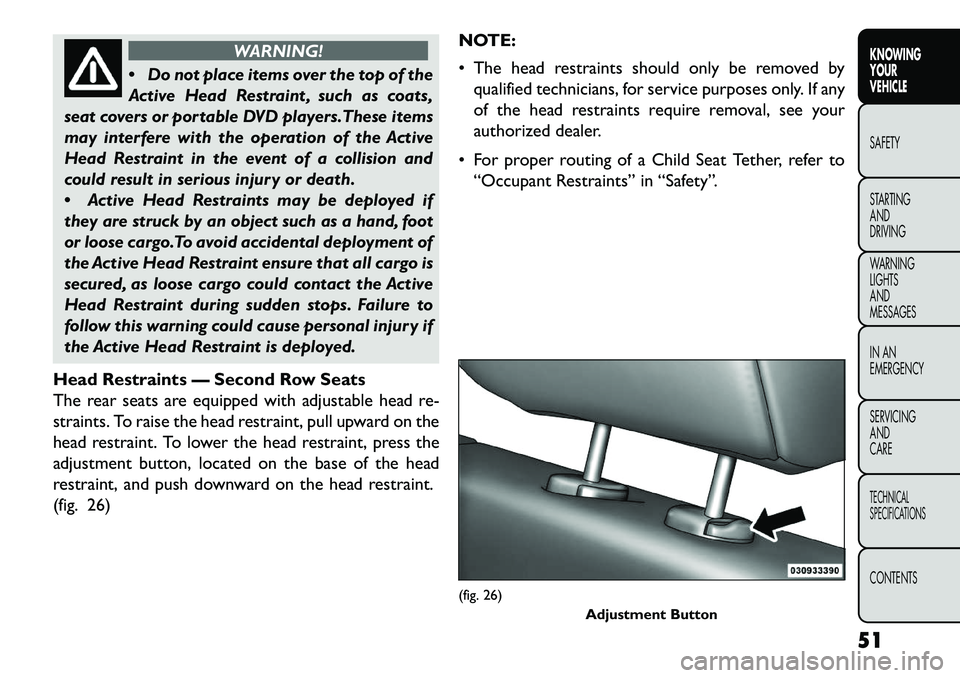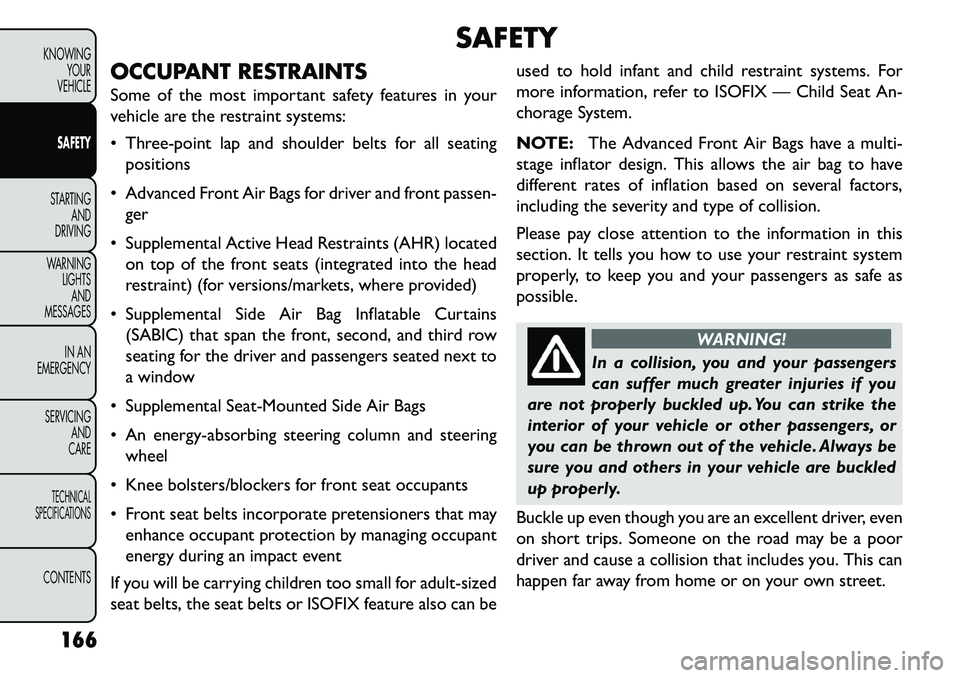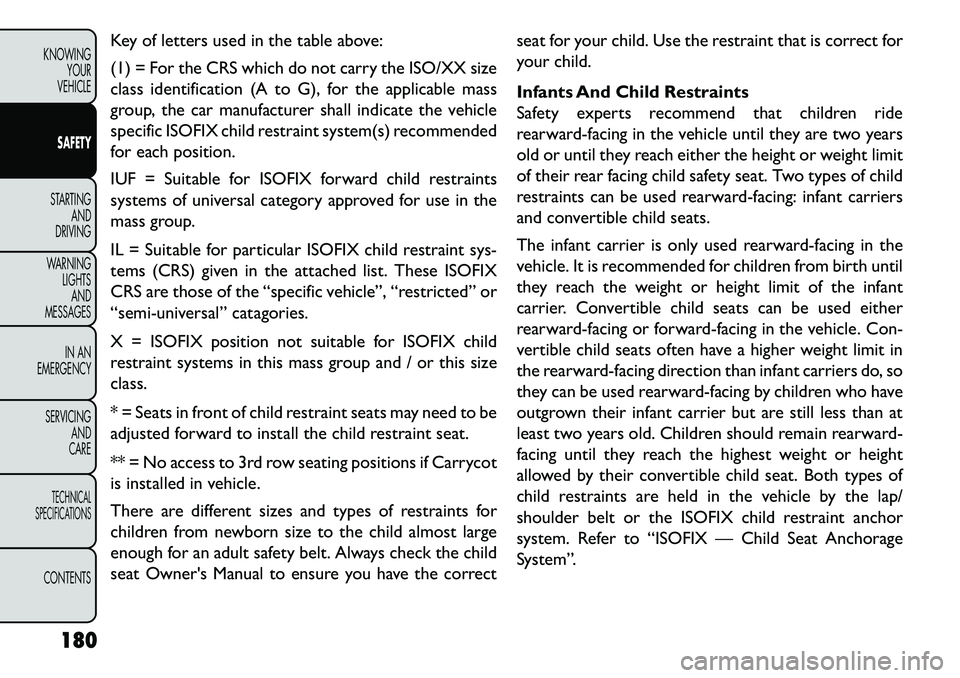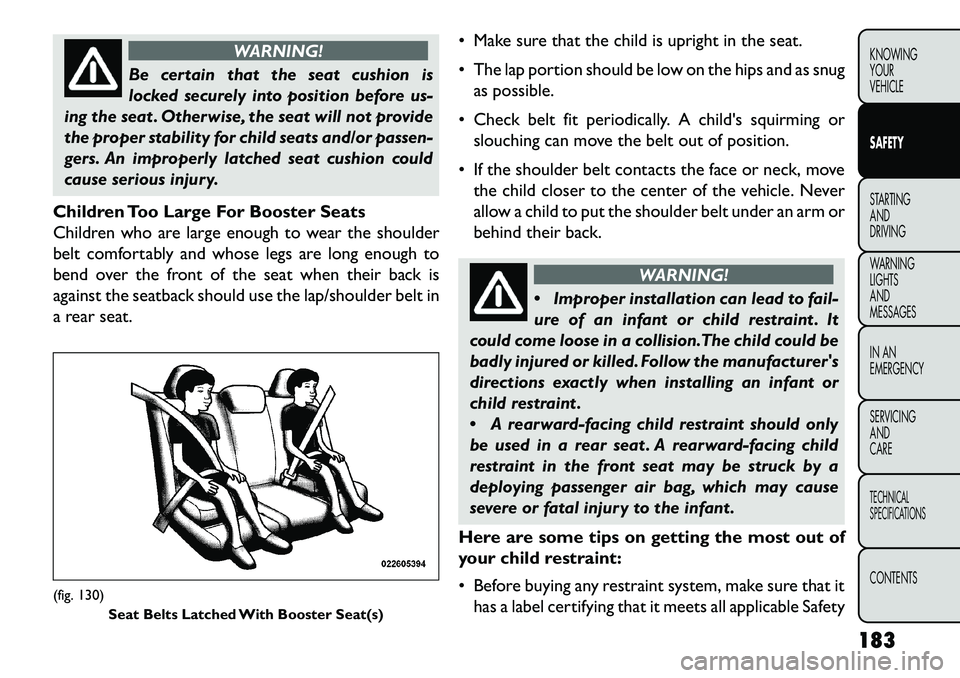child restraint FIAT FREEMONT 2013 Owner handbook (in English)
[x] Cancel search | Manufacturer: FIAT, Model Year: 2013, Model line: FREEMONT, Model: FIAT FREEMONT 2013Pages: 352, PDF Size: 5.22 MB
Page 57 of 352

WARNING!
Do
not place items over the top of the
Active Head Restraint , such as coats,
seat covers or portable DVD players.These items
may interfere with the operation of the Active
Head Restraint in the event of a collision and
could result in serious injury or death.
Active Head Restraints may be deployed if
they are struck by an object such as a hand, foot
or loose cargo.To avoid accidental deployment of
the Active Head Restraint ensure that all cargo is
secured, as loose cargo could contact the Active
Head Restraint during sudden stops. Failure to
follow this warning could cause personal injury if
the Active Head Restraint is deployed.
Head Restraints — Second Row Seats
The rear seats are equipped with adjustable head re-
straints. To raise the head restraint, pull upward on the
head restraint. To lower the head restraint, press the
adjustment button, located on the base of the head
restraint, and push downward on the head restraint.
(fig. 26) NOTE:
The head restraints should only be removed by
qualified technicians, for service purposes only. If any
of the head restraints require removal, see your
authorized dealer.
For proper routing of a Child Seat Tether, refer to “Occupant Restraints” in “Safety”.
(fig. 26) Adjustment Button
51
KNOWING
YOUR
VEHICLE
SAFETY
S
TARTING
AND
DRIVING
WARNING
LIGHTS
AND
MESSAGES
IN AN
EMERGENCY
SERVICING
AND
CARETECHNICAL
SPECIFICATIONSCONTENTS
Page 63 of 352

Adjust the seat track position as desired. Using body
pressure, move forward and rearward on the seat to be
sure that the seat adjusters have latched.
WARNING!
Be certain that the seatback and seat
are
locked securely into position. Other-
wise, the seat will not provide the proper stability
for child seats and/or passengers. An improperly
latched seat could cause serious injury.
50/50 SPLIT THIRD-ROW PASSENGER
SEATS WITH FOLD-FLAT FEATURE (Seven
Passenger Models)
To provide additional storage area, each third-row
passenger seatback can be folded flat. This allows for
extended cargo space and still maintains some rear
seating room if needed.
NOTE: Prior to folding the third-row passenger
seatback, make sure the second-row passenger seat-
back is not in a reclined position. This will allow the
seatback to fold easily. To Fold The Seatback
Pull the latch release-loop located at the top of the
seatback upward, push the seatback forward slightly,
and release the release-loop. Then, continue to push
the seatback forward. The head restraints will fold
automatically as the seatback moves forward. (fig. 33)
(fig. 33)
Seatback Release
57
KNOWING
YOUR
VEHICLE
SAFETY
S
TARTING
AND
DRIVING
WARNING
LIGHTS
AND
MESSAGES
IN AN
EMERGENCY
SERVICING
AND
CARETECHNICAL
SPECIFICATIONSCONTENTS
Page 172 of 352

SAFETY
OCCUPANT RESTRAINTS
Some of the most important safety features in your
vehicle are the restraint systems:
Three-point lap and shoulder belts for all seating positions
Advanced Front Air Bags for driver and front passen- ger
Supplemental Active Head Restraints (AHR) located on top of the front seats (integrated into the head
restraint) (for versions/markets, where provided)
Supplemental Side Air Bag Inflatable Curtains (SABIC) that span the front, second, and third row
seating for the driver and passengers seated next to
a window
Supplemental Seat-Mounted Side Air Bags
An energy-absorbing steering column and steering wheel
Knee bolsters/blockers for front seat occupants
Front seat belts incorporate pretensioners that may enhance occupant protection by managing occupant
energy during an impact event
If you will be carrying children too small for adult-sized
seat belts, the seat belts or ISOFIX feature also can be used to hold infant and child restraint systems. For
more information, refer to ISOFIX — Child Seat An-
chorage System.
NOTE:
The Advanced Front Air Bags have a multi-
stage inflator design. This allows the air bag to have
different rates of inflation based on several factors,
including the severity and type of collision.
Please pay close attention to the information in this
section. It tells you how to use your restraint system
properly, to keep you and your passengers as safe as
possible.
WARNING!
In a collision, you and your passengers
can
suffer much greater injuries if you
are not properly buckled up. You can strike the
interior of your vehicle or other passengers, or
you can be thrown out of the vehicle. Always be
sure you and others in your vehicle are buckled
up properly.
Buckle up even though you are an excellent driver, even
on short trips. Someone on the road may be a poor
driver and cause a collision that includes you. This can
happen far away from home or on your own street.
166
KNOWING YOUR
VEHICLE
SAFETY
STARTING AND
DRIVING
W
ARNING LIGHTS AND
MESSAGES
IN AN
EMERGENCY
SERVICING AND
CARETECHNICAL
SPECIFICATIONSCONTENTS
Page 177 of 352

2. At about 15 to 30 cm above the latch plate, graspand twist the belt webbing 180 degrees to create a
fold that begins immediately above the latch plate.
3. Slide the latch plate upward over the folded web- bing. The folded webbing must enter the slot at the
top of the latch plate.
4. Continue to slide the latch plate up until it clears the folded webbing.
SEAT BELT PRETENSIONERS
The seat belts for both front seating positions are
equipped with pretensioning devices that are designed
to remove slack from the seat belt in the event of a
collision. These devices may improve the performance
of the seat belt by assuring that the belt is tight about
the occupant early in a collision. Pretensioners work
for all size occupants, including those in child restraints.
NOTE: These devices are not a substitute for proper
seat belt placement by the occupant. The seat belt still
must be worn snugly and positioned properly.
The pretensioners are triggered by the Occupant Re-
straint Controller (ORC). Like the air bags, the preten-
sioners are single use items. A deployed pretensioner
or a deployed air bag must be replaced immediately. SUPPLEMENTAL ACTIVE HEAD
RESTRAINTS (AHR)
These head restraints are passive, deployable compo-
nents, and vehicles with this equipment cannot be
readily identified by any markings, only through visual
inspection of the head restraint. The head restraint will
be split in two halves, with the front half being soft
foam and trim, the back half being decorative plastic.
How The Active Head Restraints (AHR) Work
The Occupant Restraint Controller (ORC) determines
whether the severity, or type of rear impact will require
the Active Head Restraints (AHR) to deploy. If a rear
impact requires deployment, both the driver and front
passenger seat AHRs will be deployed.
When AHRs deploy during a rear impact, the front half
of the head restraint extends forward to minimize the
gap between the back of the occupant’s head and the
AHR. This system is designed to help prevent or
reduce the extent of injuries to the driver and front
passenger in certain types of rear impacts.
NOTE:
The Active Head Restraints (AHR) may or
may not deploy in the event of a front or side impact.
However if during a front impact, a secondary rear
impact occurs, the AHR may deploy based on several
factors, including the severity and type of the impact.
(fig. 121)
171
KNOWING
YOUR
VEHICLE
SAFETY
STARTING
AND
DRIVING
W
ARNING
LIGHTS
AND
MESSAGES
IN AN
EMERGENCY
SERVICING
AND
CARETECHNICAL
SPECIFICATIONSCONTENTS
Page 183 of 352

Pregnant women should wear the lap part of the belt
across the thighs and as snug across the hips as pos-
sible. Keep the belt low so that it does not come across
the abdomen. That way the strong bones of the hips
will take the force if there is a collision.
CHILD RESTRAINTS
Everyone in your vehicle needs to be buckled up all the
time, including babies and children.
Children 12 years or younger should ride properly
buckled up in a rear seat, if available. According to crash
statistics, children are safer when properly restrained
in the rear seats rather than in the front.(fig. 127)
WARNING!
“E
xtreme Hazard! Do not use a
rearward-facing child restraint on a seat
protected by an air bag in front of it!” Refer to
visor and door shut face mounted labels for infor-
mation.
In a collision, an unrestrained child, even a tiny
baby, can become a projectile inside the vehicle.
The force required to hold even an infant on your
lap could become so great that you could not
hold the child, no matter how strong you are.The
child and others could be badly injured. Any child
riding in your vehicle should be in a proper re-
straint for the child's size.
(fig. 127)
177
KNOWING
YOUR
VEHICLE
SAFETY
STARTING
AND
DRIVING
W
ARNING
LIGHTS
AND
MESSAGES
IN AN
EMERGENCY
SERVICING
AND
CARETECHNICAL
SPECIFICATIONSCONTENTS
Page 184 of 352

Mass GroupSeating Position (or other site)
Front
Passenger Rear Outboard Rear Center Intermediate
Outboard Intermediate
Center
Group — up to 10 kg X*U N/A**UU
Group 0+ — up to 13 kg X*U N/A**UU
Group 1 – 9 to 18 kg X*U N/A**UU
Group II – 15 to 25 kg X*U N/A**UU
Group III — 22 to 36 kg X*U N/A**UU
Key of letters used in the table above:
U = Suitable for “universal” category restraints ap-
proved for use in this mass group.
UF = Suitable for forward-facing “universal” category
restraints approved for use in this mass group.
L = Suitable for particular child restraints given on
attached list. These restraints may be of the “specific
vehicle,” “restricted” or “semi-universal” categories.
B = Built-in restraint approved for this mass group.
X = Seat position not suitable for children in this mass
group. * = If a child seat is to be used in the third row, the
second row seat back directly in front of the child seat
must be folded flat if the seat back can not be locked in
a upright position.
** = If a child seat is to be used in the second row, the
first row seat directly in front of the child seat may
need to be limited in its rearward travel to avoid any
contact with the child seat.
178
KNOWING YOUR
VEHICLE
SAFETY
STARTING AND
DRIVING
W
ARNING LIGHTS AND
MESSAGES
IN AN
EMERGENCY
SERVICING AND
CARETECHNICAL
SPECIFICATIONSCONTENTS
Page 186 of 352

Key of letters used in the table above:
(1) = For the CRS which do not carry the ISO/XX size
class identification (A to G), for the applicable mass
group, the car manufacturer shall indicate the vehicle
specific ISOFIX child restraint system(s) recommended
for each position.
IUF = Suitable for ISOFIX forward child restraints
systems of universal category approved for use in the
mass group.
IL = Suitable for particular ISOFIX child restraint sys-
tems (CRS) given in the attached list. These ISOFIX
CRS are those of the “specific vehicle”, “restricted” or
“semi-universal” catagories.
X = ISOFIX position not suitable for ISOFIX child
restraint systems in this mass group and / or this size
class.
* = Seats in front of child restraint seats may need to be
adjusted forward to install the child restraint seat.
** = No access to 3rd row seating positions if Carrycot
is installed in vehicle.
There are different sizes and types of restraints for
children from newborn size to the child almost large
enough for an adult safety belt. Always check the child
seat Owner's Manual to ensure you have the correctseat for your child. Use the restraint that is correct for
your child.
Infants And Child Restraints
Safety experts recommend that children ride
rearward-facing in the vehicle until they are two years
old or until they reach either the height or weight limit
of their rear facing child safety seat. Two types of child
restraints can be used rearward-facing: infant carriers
and convertible child seats.
The infant carrier is only used rearward-facing in the
vehicle. It is recommended for children from birth until
they reach the weight or height limit of the infant
carrier. Convertible child seats can be used either
rearward-facing or forward-facing in the vehicle. Con-
vertible child seats often have a higher weight limit in
the rearward-facing direction than infant carriers do, so
they can be used rearward-facing by children who have
outgrown their infant carrier but are still less than at
least two years old. Children should remain rearward-
facing until they reach the highest weight or height
allowed by their convertible child seat. Both types of
child restraints are held in the vehicle by the lap/
shoulder belt or the ISOFIX child restraint anchor
system. Refer to “ISOFIX — Child Seat Anchorage
System”.
180
KNOWING YOUR
VEHICLE
SAFETY
STARTING AND
DRIVING
W
ARNING LIGHTS AND
MESSAGES
IN AN
EMERGENCY
SERVICING AND
CARETECHNICAL
SPECIFICATIONSCONTENTS
Page 187 of 352

WARNING!
Rearward-facing child seats must never
be
used in the front seat of a vehicle with
the front passenger air bag. An air bag deploy-
ment could cause severe injury or death to in-
fants in this position.
Older Children And Child Restraints
Children who are two years old or who have outgrown
their rear-facing convertible child seat can ride
forward-facing in the vehicle. Forward-facing child
seats and convertible child seats used in the forward-
facing direction are for children who are over two years
old or who have outgrown the rear-facing weight or
height limit of their rear-facing convertible child seat.
Children should remain in a forward-facing child seat
with a harness for as long as possible, up to the highest
weight or height allowed by the child seat. These child
seats are also held in the vehicle by the lap/shoulder
belt or the ISOFIX child restraint anchorage system.
Refer to “ISOFIX — Child Seat Anchorage System”. All children whose weight or height is above the
forward-facing limit for the child seat should use a
belt-positioning booster seat until the vehicle’s seat
belts fit properly. If the child cannot sit with knees bent
over the vehicle's seat cushion while the child's back is
against the seatback, they should use a belt-positioning
booster seat. The child and belt-positioning booster
seat are held in the vehicle by the lap/shoulder belt.
Integrated Child Booster Seat (for
versions/markets, where provided)
The Integrated Child Booster Seat is located in each
outboard second-row passenger seat.
NOTE:
Refer to the Integrated Child Booster Seat
information label located on the front lower panel of
the opened Booster Seat for child weight specifica-
tions.
To position a child into the Integrated Child Booster
Seat follow these steps:
1. Slide the second row seat to the full rear position to use the Integrated Child Booster Seat.
NOTE: The second row bench with Integrated Child
Booster Seat must remain in the full rear position
during use.
181
KNOWING
YOUR
VEHICLE
SAFETY
STARTING
AND
DRIVING
WARNING
LIGHTS
AND
MESSAGES
IN AN
EMERGENCY
SERVICING
AND
CARETECHNICAL
SPECIFICATIONSCONTENTS
Page 189 of 352

WARNING!
Be certain that the seat cushion is
lock
ed securely into position before us-
ing the seat . Otherwise, the seat will not provide
the proper stability for child seats and/or passen-
gers. An improperly latched seat cushion could
cause serious injury.
Children Too Large For Booster Seats
Children who are large enough to wear the shoulder
belt comfortably and whose legs are long enough to
bend over the front of the seat when their back is
against the seatback should use the lap/shoulder belt in
a rear seat. Make sure that the child is upright in the seat.
The lap portion should be low on the hips and as snug
as possible.
Check belt fit periodically. A child's squirming or slouching can move the belt out of position.
If the shoulder belt contacts the face or neck, move the child closer to the center of the vehicle. Never
allow a child to put the shoulder belt under an arm or
behind their back.
WARNING!
Impro
per installation can lead to fail-
ure of an infant or child restraint . It
could come loose in a collision.The child could be
badly injured or killed. Follow the manufacturer's
directions exactly when installing an infant or
child restraint .
A rearward-facing child restraint should only
be used in a rear seat . A rearward-facing child
restraint in the front seat may be struck by a
deploying passenger air bag, which may cause
severe or fatal injury to the infant .
Here are some tips on getting the most out of
your child restraint:
Before buying any restraint system, make sure that it has a label certifying that it meets all applicable Safety
(fig. 130) Seat Belts Latched With Booster Seat(s)
183
KNOWING
YOUR
VEHICLE
SAFETY
STARTING
AND
DRIVING
W
ARNING
LIGHTS
AND
MESSAGES
IN AN
EMERGENCY
SERVICING
AND
CARETECHNICAL
SPECIFICATIONSCONTENTS
Page 190 of 352

Standards. FIAT also recommends that you make
sure that you can install the child restraint in the
vehicle where you will use it before you buy it.
The restraint must be appropriate for your child's weight and height. Check the label on the restraint
for weight and height limits.
Carefully follow the instructions that come with the restraint. If you install the restraint improperly, it may
not work when you need it.
Buckle the child into the seat according to the child restraint manufacturer's directions.
WARNING!
When your child restraint is not in use,
s
ecure it in the vehicle with the seat belt
or remove it from the vehicle. Do not leave it
loose in the vehicle. In a sudden stop or collision,
it could strike the occupants or seatbacks and
cause serious personal injury.
ISOFIX — Child Seat Anchorage System
Your vehicle's second row passenger seats are
equipped with the child restraint anchorage system
called ISOFIX. The ISOFIX system provides for the
installation of the child restraint without using the
vehicle's seat belts, instead securing the child restraint using lower anchorages and upper tether straps from
the child restraint to the vehicle structure.
ISOFIX-compatible child restraint systems are now
available. However, because the lower anchorages are
to be introduced over a period of years, child restraint
systems having attachments for those anchorages will
continue to have features for installation using the
vehicle's seat belts. Child restraints having tether straps
and hooks for connection to the top tether anchorages
have been available for some time. For some older child
restraints, many child restraint manufacturers offer
add-on tether strap kits or retrofit kits. You are urged
to take advantage of all the available attachments pro-
vided with your child restraint in any vehicle.
All three second-row passenger seating positions have
lower anchorages that are capable of accommodating
ISOFIX-compatible child seats. You should never install
ISOFIX-compatible child seats so that two seats share
a common lower anchorage. If installing child seats in
adjacent seating positions, or if your child restraints are
not ISOFIX-compatible, install the restraints using the
vehicle's seat belts. (fig. 131)
184
KNOWING YOUR
VEHICLE
SAFETY
STARTING AND
DRIVING
W
ARNING LIGHTS AND
MESSAGES
IN AN
EMERGENCY
SERVICING AND
CARETECHNICAL
SPECIFICATIONSCONTENTS